
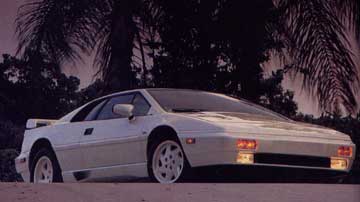
Lotus Esprit Turbo
Carrying on in the Chapman tradition
Motor Trends February 1988
by Ron Grable
photography by Vic Huber
Fact: Nonchalantly parking this sucker in front of the house guarantees the undivided attention of the entire neighbourhood. They figure, at the very least, you sold short the day before the market crash or that, on the last family beach outing in Miami, you found a large burlap parcel floating by.
All the menfolk find some excuse to wander by for perfunctory tire kicking and then, straight as an arrow, get right to the two important questions – what and how much. 'Lotus, eh? Don't they race these overseas somewhere?' When asked, just to fuel the fires a little, we usually tell everyone it sells for around 150 kilobucks; then men nod their heads knowingly, the women are unimpressed. They just want to sit in it.
Mike Kimberley, Lotus chief exec, claims this restyled '88 model Esprit Turbo is a 'stepping stone' for a whole new era at Lotus, a period that will see them producing a supercar to do battle with the Ferrari Testarossas of this world. He was tantalisingly evasive about any detail description of this future Lotus, but did say it would be in the Ferrari F40 class in terms of performance, with all the accoutrements expected in such stratospheric cars, plus some cutting-edge electronic and materials technologies. The idea of Lotus producing a supercar to compete against the likes of the F40 and the new LT-5 Corvette precipitates thoughts of a war between manufacturers. Such a scenario in the Japanese motorcycle industry generated a leapfrog technology, which produced astounding new superbikes year after year. Could this happen in our industry? We can only hope.

For this '88 car, Lotus engineers decided to carry over the chassis and driveline unchanged, concentrating their efforts instead on the exterior/interior styling and aerodynamics. Colin Spooner, director of design, was charged with the responsibility of creating a contemporary car that would 'bolt on' the chassis and mechanicals of the current angular-look (dating back to 1975) Esprit.
It's certainly no easy task to 'modernise' an existing design, even given the freedom to change the entire body. When faced with such an update project, most designers would prefer to start with a clean sheet of paper so they can control the basic proportions of the finished vehicle. Even though the '87 Turbo Esprit body design is looking a little long in the tooth, its basic proportions are quite sound, allowing Colin to give the new-generation car an entirely different look. Contemporary, yes, but with a subtle aero-look that also manages to exude quality and an understated supercar persona, difficult to quantify. As you can tell, we like it, as does everyone we asked.
When you first see the car, it's easy to assume it's entirely new. Some of the original Esprit styling cues are still there, but, unless you know, it's difficult to believe it's a rebody of the '87 Turbo Esprit. Park an '87 next to the new one, and the heritage and changes are obvious – but not until then.
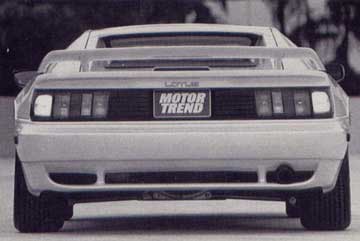
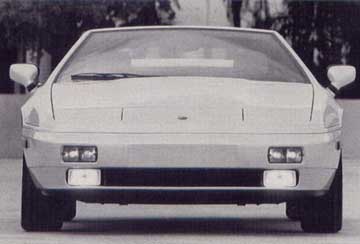
One of the most significant changes (from a styling standpoint) is the integrated 'knock-resistant' bumpers. They are injection-moulded plastic, meet EPA requirements for impact, and integrate into the body lines well enough as to be almost invisible – all (especially the last) important criteria for bumpers. Additional body cleanup items include flush fuel-filler doors (remote-controlled) replacing the previous screw-ons and integrated passenger compartment air intake. In the aero department, the windscreen angle and curvature are both increased, ditto the side windows, and an interesting treatment in the rear decklid area Lotus calls the 'glassback.' It is, in fact, a contoured, transparent plastic cover that continues the roofline in the engine cover area but leaves a gap sufficient to facilitate the driver's vision underneath it. We found this enhanced visibility in the rain. The rear is subtly rounded with a new, nearly flat spoiler and taillight complex.
Lotus also took the opportunity to redo the interior of the Esprit Turbo, in light of some of the shortcomings of the previous car. The most welcome change for those of us over 6ft tall was repositioning the seat to allow more longitudinal adjustment and head room, and providing more rake adjustment in the seat. The transmission tunnel (no transmission in there, folks) was also redesigned to provide increased interior space. All these changes provide the occupants with a more spacious feel, more so than would be suggested by the magnitude of the changes.
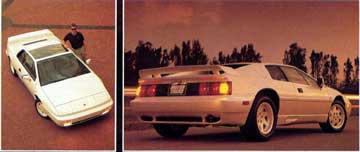
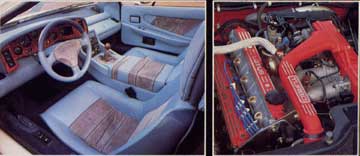
The '88 Esprit will also be offered in a Commemorative Edition model, as you can see here. Exclusivity will be guaranteed by only building 88 of them, and each will be numbered. This exclusivity will lighten your load by an additional $7,000, and for that you get: rear wing, tunnel-back styling, different lower rear valance panel, two-tone Connolly leather and suede interior treatment, a new (debuted in this car) stacked Sony sound system that includes AM/FM/graphic equaliser/compact disc/cassette, and a pearlescent white paint scheme including body-colour wheels. Before you rip your chequebook out, be advised that all 88 are sold-prior to rolling off the assembly line.
In most car companies, chassis development is done with a team of engineers, man-weeks of CAD and CAM, megabytes of computers, truckloads of test equipment, and months of work on skidpads, test tracks, and roadways. At Lotus Cars, chassis development is done by Roger Becker. He drives the cars, decides on the chassis dynamics, and makes it all happen. There are obvious dangers in the approach: What if Roger liked the way '55 Cadillacs handled, for instance? Luckily he doesn't, and the Esprit has been custom-tailored by Mr. Becker to handle the idiosyncrasies of European high-speed touring.
It's difficult for American drivers to understand the unique demands of Euro-type touring. First, average speeds are significantly higher, and, second, the roads are much narrower, more crowned, and not as smooth, with many blind intersections, driveways, etc. Mr. Becker does a portion of his testing on the small country roads surrounding the Lotus factory in Norwich, England, and, when he recently offered a ride, we jumped at the chance.
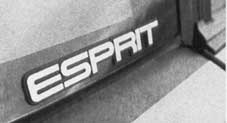
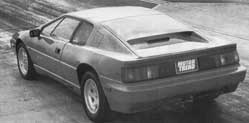
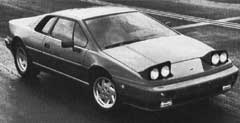
A ride with Roger on a typical test session is best described as one long, continuous carrier landing. Sitting on the wrong side of the car without a steering wheel is the first problem; the hedgerows rubbing on my side of the car at 100mph is another; and not knowing the roads as Roger blasts around blind corners at transonic speeds is a third. The back roads are so narrow that Roger must literally run the outside (my side) wheel off the paved surface when faced with oncoming traffic. He does this with complete aplomb.
After the initial terror subsides, it's apparent the Esprit Turbo is uniquely qualified to deal with these conditions (which Roger asserts are the standard of European touring), while maintaining high average speeds. And it provides a high degree of passenger safety in the form of chassis dynamics that give the driver an adequate safety margin: long travel, compliant suspension with good damping rates for narrow, bumpy roads, a chassis balance that gives predictable, controllable understeer, and an exemplary steering system. The steering provides instantaneous feedback to the driver about the road surface without being too heavy and is totally linear.
The only flaw in this otherwise killer package is brakes. The lack of ABS on a car of this potential is surprising. Don't misunderstand, the Esprit brakes are powerful and well-balanced, but a good anti-lock system would be icing on the cake. It still rains and snows, and panic stops do happen. ABS would simply offer the customer added safety margins.
The little 2.2-litre 4-cylinder turbocharged engine in the Esprit is unchanged this year, but continues to impress with its smoothness and useable power range. It excludes a high-tech fell: the aura of doing the job with minimum displacement and high revs as opposed to a big-displacement torquer. Turbo lag exists, but is hardly noticeable after a little familiarisation with the car. The engine is tractable at 3000rpm, and top gear passes usually don't require a lower gear. If a lower passing exposure time is required, just drop a gear or two, to get at least 4000rpm on the clock, and you're gone. The engine really pushes had from 4000rpm right up to its 6500rpm redline, and never feels out of breath – it feels like the redline on the taco is too early.
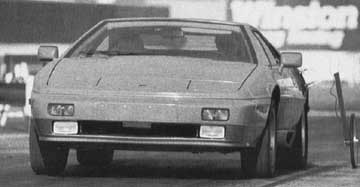
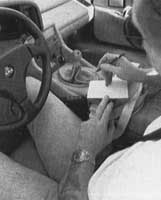
The performance data generated in our testing session underlines the fact that the chassis and drivetrain are unchanged from 1987. Acceleration, braking, skidpad, and slalom are all nearly equal to the last test we did with the Esprit Turbo. Both skidpad and slalom times are compromised slightly by the design intent for the car: high speeds over European-type roads. It would be possible to get better lateral acceleration performance on the skidpad and a higher speed through the slalom by altering the roll stiffness distribution, front to rear, to reduce understeer. Likewise, shock valving the bushing compliance could be altered to make the car more responsive in transient manoeuvres like slalom.
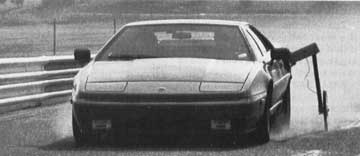
Rest assured, Roger Becker knows this. He also knows those changes would have a negative effect on the car's driveability at high speeds. It would be more "twitchy." Being able to maintain high average speeds means occasionally arriving at a corner faster than desired. The way the Esprit is currently set up, it'll scrub off the unwanted speed by pushing its front end entering the corner. Set up in the twitchy configuration, the same scenario would cause a lot more drama, with the car wanting to oversteer entering the corner – an immeasurably more difficult control problem. Again, this car is configured to be comfortable to drive fast, and it is exactly that.
The handling dynamics are best described as confidence-building. After driving the car for a while, the driver gets comfortable with high speeds and begins to appreciate the inherent touring ability of this vehicle. High average speeds are possible – make that easy – for long periods without fatigue. At 100mph, the car settles into a solid 'harmonic', where all engine vibrations smooth out, wind noise is gone, the rotating masses of the wheels, tires, brake discs seem to cancel out – even the mirrors are quiet – and you find yourself turning the radio down just to enjoy the sensations. Strange thoughts emerge. Turbines . . . space vehicles . . . travelling through the void. The Esprit Turbo, in its element, successfully isolates its passengers from the trials of earthly transportation. It's a capsule that transports them from A to B, the tire contact patches the only grudging contact with the planet.
It's at its best on corner exit. Get everything just right – correct gear, rpm above 4000, turbo spooled up, car pointed at the apex – and it just explodes off the corner, ears pinned back and accelerating like an F-16 in full afterburn. Sure makes us grin. We recommend you try it at your earliest convenience. If we were submitting our Christmas wish list for the Lotus, it would include: ABS, cruise control, more interior storage space, adjustable steering wheel, better pedal arrangement for heel-and-toe, and provisions to clean under the 'glassback'. We're not nitpicking here, just fine-tuning.

Lotus has bitten off a large chunk with this vehicle. At $62,500, it's certainly in a league were customers are discriminating, although exactly what motivates buyers for these stratospheric vehicles is a subject of some controversy.
Actually, in this automotive strata, the Lotus represents somewhat of a 'bargain' if comparison-shopped against its competition. The 928S 4 Porsche is pushing hard against the $70,000 level, ditto the 560SEL Merc, Porsche 911 Turbo, and 328 Ferrari. The fact that this car comes with a 4-cylinder engine is of possible concern to some potential customers, perceived value and all that, notwithstanding the fact that this is one fine motor that performs right up there with its more cylinder-endowed competitors. The reliability question has plagued Lotus for some time, and the Esprit has developed a bad reputation in this area. Mike Kimberley and staff are committed to changing that. We are unable to speak to the question at this time because of our limited time with the cars. The one we tested for this story was totally bullet-proof during the entire time we had it, and it was shown no mercy. No complaints for the car after multiple dragstrip runs, a groove worn around the skidpad, and enough slalom runs to make everyone on the staff sick.
We think there's room in the market segment for the Lotus, and that it will do well. It's hard to resist this car just from an emotional point of view; aesthetically, it holds its head high in any company. We think it's gorgeous. We like the engine. We like the interior. It makes us smile. We want our very own.
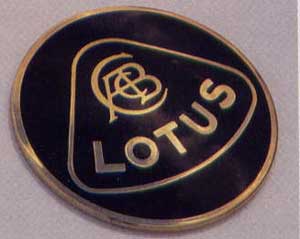
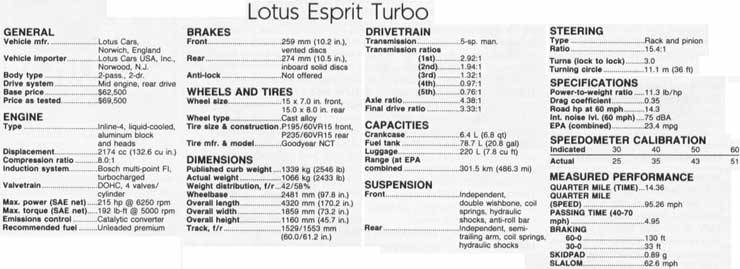
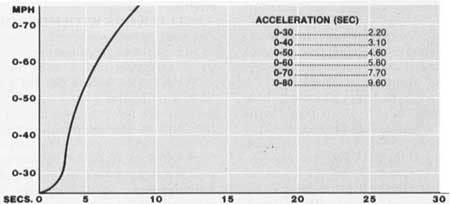
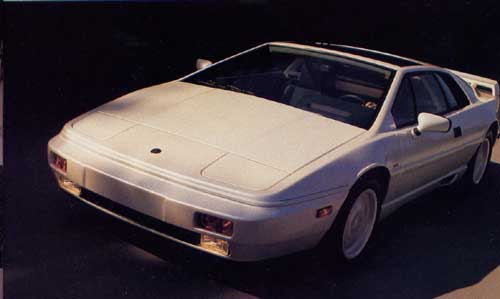
|
|